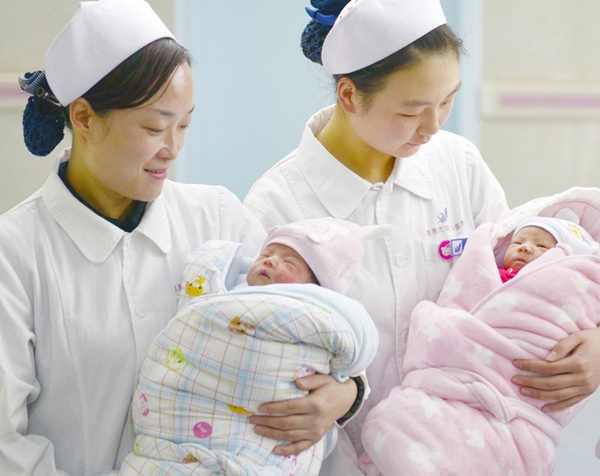Demographic challenge calls for serious response
Updated: 2016-01-22 07:36
(China Daily)
|
|||||||||||
 |
|
Obstetric nurses in the Central Hospital of Enshi, Hubei province, take care of newborns at the hospital. [Photo provided to China Daily] |
Buried deep in the latest official statistics about China's economic and social development in 2015 is the fact that the number of the country's newborns decreased to 16.55 million last year, 320,000 fewer than 2014.
That dip may look trivial in a country of 1.37 billion people. But it contrasts sharply with the general belief that the effect of the change to the family planning policy in 2013, that allowed couples with either the husband or the wife being an only child to have a second child, should have kicked in by now to alleviate the downward trend of the population.
The unexpected dip should, at least, warrant an immediate and careful review of the implemented policy because the stakes cannot be higher given the rapidly aging Chinese population.
As the world's most populous country, China has benefited tremendously from the ample supply of labor during its economic take-off over the past three decades. But that demographic windfall is morphing into a headwind as the number of people aged 60 and older has soared to 222 million while the decline of the working age population between 16 and 59 has accelerated, falling by 4.87 million people in 2015, about 1 million more than the previous year.
Nevertheless, the prompt explanation the National Health and Family Commission offered for the reduction in the number of newborns in 2015 sounds farfetched rather than a sincere attempt to recognize the pressing demographic challenges.
Besides the decreasing number of women of childbearing age, the health authorities blamed the Year of the Goat, believed to be an inauspicious birth sign by some people, for the decline. And it projected that China will welcome 17.5-to-21 million newborns annually in the five years after the passing of the Year of the Goat.
It may indeed be difficult for the health authorities to come up with a scientific and well-supported explanation so soon after the release of latest statistics on demographic changes.
But such a creative use of superstition neither helps understand the real demographic challenges nor adds credibility to the estimate for population growth, which is crucial to the design of a functioning social security and healthcare system in the long run.
A more thorough and serious review of the latest population changes is needed to allow the country to respond appropriately to prevent a demographic crisis from happening.
Related Stories
Beijing sees slower population growth 2016-01-20 10:04
Working-age population plummets 2016-01-20 07:55
Richest 62 people own same as half world's population - Oxfam 2016-01-18 10:47
Tibet sees growth in wildlife population 2015-12-31 16:03
Today's Top News
China gives beleaguered Tsipras a helping hand
China and Gulf nations resume free trade talks
IMF starts to select new chief
Merkel insists on European solution for refugee crisis
China, Saudi Arabia sign deals on Xi's visit
Hollande announces $2.2b plan to create jobs
Chinese conductor becomes first woman in charge of BBC orchestra
Taxi drivers in Budapest protests against Uber
Hot Topics
Lunar probe , China growth forecasts, Emission rules get tougher, China seen through 'colored lens', International board,
Editor's Picks

|

|

|

|

|

|






